HT Talks To: Mike Inchalik
Most consumers take for granted the awesome video quality of DVD. You might never consider the often decrepit physical condition of many of your favorite classic movies, which were shot on a variety of film stocks and have suffered any number of indignities over the ensuing decades. We discuss restoration frequently in these pages, but many readers want to know more. So, we went to the unrivaled experts. DTS Digital Images—formerly Lowry Digital Images—was founded by the now legendary John Lowry, whose name has become a seal of approval on well over 100 celebrated film restorations. Exclusively for HT, Mike Inchalik of DTS Digital Images pulled back the curtain on their closely guarded, much envied process.
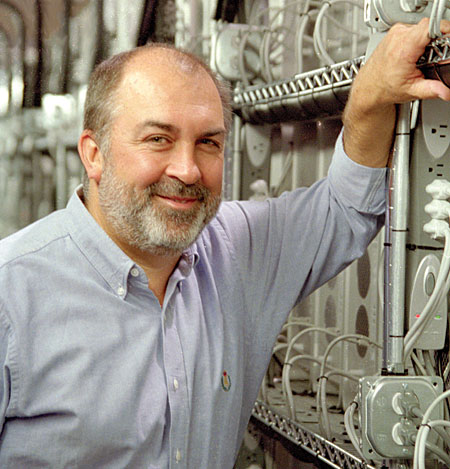
Let's start with a basic one: How do you restore a movie?
There are six basic steps in restoring a movie. Step one: Inspect and repair the starting film elements. Generally speaking, the studios identify the best surviving film elements from a movie. Their choices often include the original camera negative, interpositives copied from the camera negative, internegatives copied from the interpositives, separations made for long-term storage, or a print. We inspect them by hand, frame by frame to ensure the integrity of the film. We repair tears in the film and torn sprocket holes in order to ensure the film will transport through the film scanner well.
Step two: Digitize the reels of the movie. At DTS Digital Images, we do this on Imagica film scanners, which can convert normal 35mm film frames into approximately 10 million pixels of information with approximately 30 total bits of color information per pixel. This represents all of the image information that exists on a typical 35mm original camera negative. When we are done, we generally have between 100,000 and 200,000 individual, uncompressed digital image files on our storage servers.
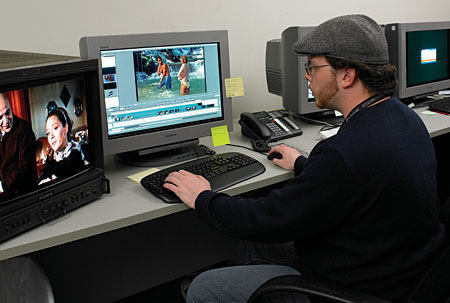
Jeff Schiffman of DTS doing quality control on some Bond titles
Step three: image processing. One of our image-processing experts views the digitized movie to identify the kinds of imaging problems contained in it and then runs a series of tests to determine the best image-processing settings to use. This allows us to optimize our results regardless of film-stock changes, natural versus artificial lighting, stationary versus moving camera, and so on. We routinely correct jitter and weave in a picture. We also remove the flicker and color breathing that develop as the dye in the film fades. We eliminate dirt, scratches, warping at splices, and other physical imperfections, and we reduce film grain and enhance the detail.
Step four: digital retouching. Automated computer algorithms need a digital artist to review the results and make occasional corrections to address anything that the automated processing pass has missed.
Step five: color correction. We make color adjustments to each shot to match slight differences in exposure, color, and so on, which occur because of differences in film stock, camera angles, film development, and aging. We also actually change the images exposed during shooting to impart a specific look as the director has dictated. One color-correction pass is dedicated to achieving the best look on new film elements. We do a second pass to correct the image files for projection in a digital cinema, which has a slightly different look than film. Then we correct the image files a third time to suit home viewing, [addressing] the "lights up" environment most common in the home rather than the fully darkened environment in the cinema.
Step six: output masters and Q.C. [quality control]. For movie restorations, we often create a number of masters using a laser film recorder that utilizes a series of sweeping red, green, and blue lasers to expose film from the data that comes from the cleaned and restored digital files, frame by frame. In addition, we create digital cinema masters using the new Digital Cinema Initiative specification for data compression and encoding. Finally, we make home-video masters and deliver them as a multitude of high-definition formatted images on D5 or HDCAM tapes for HD and as PAL and NTSC digibeta tapes for standard definition.
What is the most common problem you face on a movie in need of restoration?
The need for stabilization, grain reduction, and detail enhancement. And, of course, whether starting from the original negative or a dupe of the original negative, there is dye fade and handling damage to contend with, as well.
I had heard that DTS Digital Images uses the 11th most powerful computer in the world. . .?
We don't know if that's accurate anymore. Apple made this statement two years ago after computing the total processing horsepower that exists within DTS DI and by comparing it to the processing available at supercomputing centers around the world. To be technically accurate, it was not a comparison of single computers but the comparison of facility computing capability.
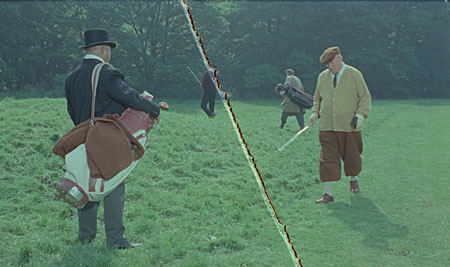
Goldfinger before restoration
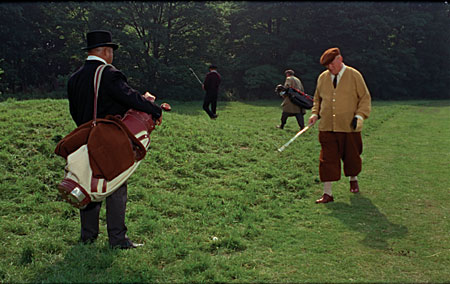
Goldfinger after restoration
Has it always been a digital process?
Restoration here has always been a digital process, but, in the industry itself, restoration has only recently begun to incorporate digital processes. Specialized photochemical film laboratories have been preserving film elements for decades, but photochemical techniques were limited in the improvements they could deliver.
How are HD DVD and Blu-ray going to affect your work?
HD DVD and Blu-ray will raise the bar for quality. HD DVD and Blu-ray demand much higher levels of compression than standard-definition DVDs do, so our high-definition masters must hold up under these much more challenging conditions. Noise, instability, and other subtle image problems will probably appear most frequently as block artifacts. If we're right, your readers will be among the very first to see these issues—and will probably be the most vocal about them, too!
There is a downside to the process, though, right?
No. In our first year of operation, we made a few mistakes. On the restoration of Citizen Kane, we were rightly taken to task for removing rain from outside a window in an office scene. Of course, that was six years ago. I'm happy to say that we did Singin' in the Rain for Warner Brothers shortly thereafter, and we left all the raindrops intact.
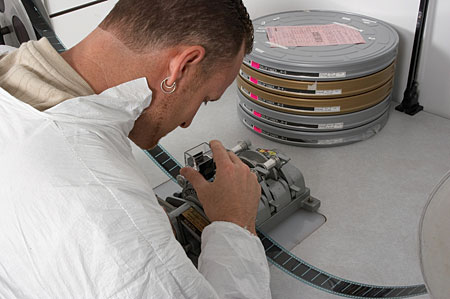
As part of the painstaking restoration process, the film restorer inspects each frame in the reels of an original, cut camera negative.
How much film grain is appropriate in a modern video master?
Film purists have often taken the position that film grain should never be changed. Having worked for Eastman Kodak for 25 years, I am extremely sensitive to this way of thinking and completely agree that many cinematographers use film grain as a part of their craft and make it an integral part of their storytelling. Nevertheless, I believe that the opinion that the film grain should never be altered is too sweeping a generalization.
Which title gives you the most pride? What do you consider some of the company's greatest hits?
Such films as the Star Wars trilogy for Lucasfilm, Breakfast at Tiffany's for Paramount, many animated classics, and, most recently, the entire library of 20 James Bond films for MGM.
Right, the James Bond canon has been getting quite a bit of buzz lately.
We are proud to have completed the restoration of all 20 James Bond titles, nine of them from the original negative at 4K resolution. I'm sure you'll be hearing a lot from MGM about them, but I can tell you this: They look absolutely stunning. They look like movies set in the 1960s, '70s, '80s, and '90s, but they look like they were shot last week. It was a privilege to work on them. Every day we marveled at how much detail was in these original camera negatives and how spectacular the color and tone scale was. Nobody has ever seen these films this way.
- Log in or register to post comments




































































